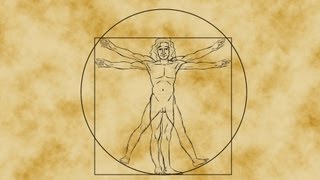(单词翻译:单击)
This image of the Vitruvian Man, taken from Leonardo's sketches,
这幅《维特鲁威人》是达芬奇著作之一,
has become one of the most recognizable symbols of the Renaissance.
也是文艺复兴时期最广为人知的一个标志。
But why? It's a simple pen and ink drawing, right? Wrong!
但是为什么呢?它只是一幅简单的钢笔画,不是吗?并非如此!
Let's start to answer this question with a math problem.
我们从数学角度来回答这个问题。
I know how to calculate the area of a circle.
我们都知道怎么计算圆的面积。
I take the value for pi and multiply it by the radius squared.
用圆周率pi乘以半径的平方。
I also know how to take the area of a square. I multiply the base by itself.
我们也都知道怎么计算正方形的面积。等于底边的平方。
But how can I take the area of a circle and create a square with an equal area?
但是我们如何才能得到一个与圆面积相等的方形呢?
This is a problem often called "squaring a circle" that was first proposed in the ancient world.
这个问题一般称为“化圆为方”,早在古代就有人提出来。
And like many ideas of the ancient world, it was given new life during the Renaissance.
也与许多其他古人留下的问题一样,“化圆为方”问题在文艺复兴期间得到了新生。
As it turns out, this problem is impossible to solve because of the nature of pi, but that's another story.
虽然结果显示这个问题是无解的,主要原因在于圆周率pi的性质,不过这又是另一回事了。
Leonardo's sketch, which is influenced by the writings of the Roman architect, Vitruvius,
达芬奇的这幅素描,受到了一位古罗马建筑师,维特鲁威的著作的启发,
places a man firmly at the center of a circle and a square.
将一个男人同时放在一个圆形和一个方形之中。
Vitruvius claimed the navel is the center of the human body and that if one takes a compass and places the fixed point on the navel,
维特鲁威提出,人的肚脐是人体的正中心,如果把圆规的一端固定在肚脐上,以此为圆心,
a circle can be drawn perfectly around the body.
可以围绕人体画出一个完美的圆。
Additionally, Vitruvius recognized that arm span and height have a nearly perfect correspondence in the human body,
维特鲁威还提出,人张开的双臂间的距离与人的身高近乎相等,
thus placing the body perfectly inside a square as well.
所以人体也就能被恰好放入一个方形。
Leonardo used the ideas of Vitruvius to solve the problem of squaring a circle metaphorically using mankind as the area for both shapes.
达芬奇借鉴了维特鲁威的想法,利用人体比例与两个图形面积间的关系,对“化圆为方”问题提出了一个间接解法。
Leonardo wasn't just thinking about Vitruvius, though.
不过达芬奇可不止受了维特鲁威的启发。
There was an intellectual movement in Italy at the time called Neoplatonism.
当时的意大利兴起了一股思潮,叫做新柏拉图主义。

This movement took an old concept from the 4th century developed by Plato and Aristotle, called "The Great Chain of Being."
这股思潮基于公元四世纪由柏拉图和亚里士多德提出“存在巨链”的旧概念之上。
This belief holds that the universe has a hierarchy resembling a chain,
这一信条认为,宇宙是一个像链条一样环环相扣的等级系统,
and that chain starts at the top with God, then travels down through the angels,
链的开端是等级最高的上帝,然后是天使,
planets, stars, and all lifeforms before ending with demons and devils.
行星,恒星,所有的生物,最后以恶魔收尾。
Early in this philosophic movement, it was thought that mankind's place in this chain was exactly in the center.
在这个哲学思潮的早期,人被放在了在这条巨链正中间的位置。
Because humans have a mortal body accompanied by an immortal soul, we divide the universe nicely in half.
因为人类同时拥有会消亡的身躯和永生的灵魂,我们刚好将宇宙一分为二。
Around the time Leonardo sketched the Vitruvian Man, however, a Neoplatonist named Pico Della Mirandola had a different idea.
但是,在达芬奇画这幅素描《维特鲁威人》的前后,一个叫皮科·德拉·米兰多拉的新柏拉图主义者提出了一个不同的概念。
He pried mankind off the chain and claimed that humans have a unique ability to take any position they want.
他将人类从巨链中分离出来,因为人类具有特殊的能力,能够在巨链中占据任何位置。
Pico claimed that God desired a being capable of comprehending the beautiful and complicated universe he had created.
皮可提出,上帝希望能有一种生物能够欣赏他所创造的美丽而复杂的宇宙。
This led to the creation of mankind, which he placed at the center of the universe with the ability to take whatever form he pleases.
上帝由此创造了人类,他将人类放在了宇宙的中心,同时让人类具有选择各种形态的能力。
Mankind, according to Pico, could crawl down the chain and behave like an animal
皮可认为,人类可以堕落到巨链的底端并表现出兽性,
or crawl up the chain and behave like a god, it's our choice.
也可以向巨链的顶端升华,表现出神性,我们可以自由选择。
Looking back at the sketch, we can see that by changing the position of the man,
回到这幅素描上来,我们可以看出,只要改变这个人的姿势,
he can fill the irreconcilable areas of a circle and a square.
他可以填满一个圆形和一个正方形这两个无法兼容的面积。
If geometry is the language the universe is written in,
如果几何是书写宇宙的语言,
then this sketch seems to say we can exist within all its elements.
那么这幅素描就暗示了我们可以与宇宙内所有的元素协调共存。
Mankind can fill whatever shape he pleases geometrically and philosophically as well.
人类可以成为任何形状,无论是几何意义上或哲学意义上。
In this one sketch, Leonardo was able to combine the mathematics, religion, philosophy, architecture, and artistic skill of his age.
就在这一幅素描里,达芬奇结合了他同代的数学,宗教,哲学,建筑以及艺术灵感。
No wonder it has become such an icon for the entire time period.
难怪这幅素描成为了那个时代如此重要的标志。


